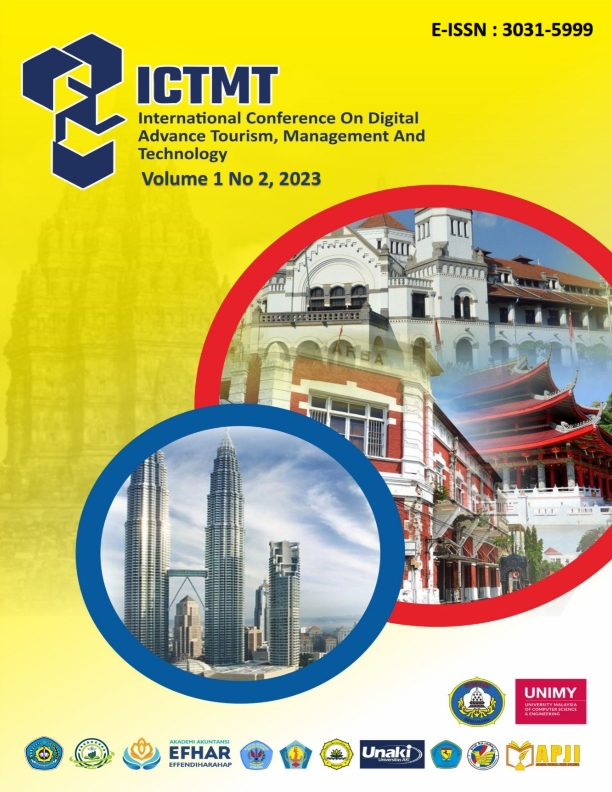Analysis Of The International Financial System in The Three Countries With the Highest Inflation Rates in The G20 Organization
DOI:
https://doi.org/10.56910/ictmt.v1i2.173Keywords:
Inflation, Exchange Rate, Money Supply, Imports, Interest RatesAbstract
This research to analyze and identify the international financial system with the highest inflation rate in three G20 member countries (Argentina, Turkey and Russia) using simultaneous methods. Data was obtained from worldbank and tradingeconomic using eviews 12 software. The research results show that there is an influence between inflation and the exchange rate, namely if the inflation rate increases it can disrupt the stability of the exchange rate. Inflation has a positive influence on the exchange rate in a country over a long period of time in the countries of Argentina, Turkiye and Russia. To control the inflation rate, this is done by monitoring the amount of money in circulation and interest rates to control the inflation rate. Advises the government through Bank sentral Indonesia to maintain the amount of money in circulation in an effort to recude the inflation rate which will then be able to maintain exchange rate stability.
References
Annazah, N. S., et al. (2017). Faktor-faktor yang memengaruhi keberhasilan redenominasi. Jurnal Ekonomi dan Kebijakan Pembangunan, 6(2).
Bashir, T. (2015). Impact of interest rate, inflation, and money supply on exchange rate volatility in Pakistan. World Applied Sciences Journal.
Cheickh, N. B., et al. (2016). Revisiting the role of inflation environment in exchange rate pass-through: A panel threshold approach. Economic Modelling, Elsevier, 52.
Egilsson, J. H. (2020). How raising interest rates can cause inflation and currency depreciation. Journal of Applied Economics, 23.
Felder, R., et al. (2008). Neoliberal reform, currency pegs, and crisis in Mexico and Argentina. Elsevier, 27.
Gujarati, D. N. (2003). Basic econometrics (3rd ed.). McGraw-Hill.
Halwani, H. (2005). Ekonomi internasional & globalisasi ekonomi. Bogor: Ghalia Indonesia.
Hardiwinoto. (2008). Cellular gold money for currency dalam sistem keuangan masa kini. Jurnal Universitas Muhammadiyah Semarang, 4(2).
Kristiyanti, S. N. (2018). Analisis pengaruh jumlah uang beredar, suku bunga, dan nilai tukar terhadap inflasi di Indonesia periode 2014–2016. Jurnal Ekonomi Manajemen Sumber Daya, 20(2), 96–103.
Liu, H., et al. (2015). Exchange rate volatility and oil price shocks. International Journal of Academic Research in Business and Social Sciences, 5(1).
Mankiw, N. G. (2007). Makroekonomi (6th ed.). Jakarta: Erlangga.
Maswana, J. C. (2006). Granger non-causality test of the inflation-exchange rate in the domestic Congo. JEL Codes: E3, 055, C22.
Mishkin, F. S. (1997). The economics of money, banking, and financial markets. England: Addison-Wesley.
Perlambang, H. (2010). Analisis pengaruh jumlah uang beredar, suku bunga SBI, nilai tukar terhadap tingkat inflasi. Media Ekonomi, 19(2), 49–68.
Purba, J. H. V., & Magdalena, A. (n.d.). Pengaruh nilai tukar terhadap ekspor dan dampaknya terhadap pertumbuhan ekonomi Indonesia. Jurnal Samudra Ekonomika, 2(1), 38–52.
Putri, V. K. (2017). Analisis pengaruh jumlah uang beredar, suku bunga sertifikat Bank Indonesia, dan suku bunga kredit investasi terhadap inflasi di Indonesia. Jurnal Online Mahasiswa Fakultas Ekonomi Universitas Riau, 4(1).
Rangkuty, D. M., & Hidayat, M. (2021). Does foreign debt have an impact on Indonesia's foreign exchange reserves? Ekulibrium Journal, 16(1), 85–93.
Rangkuty, D. M., & Mesra, B. (2022). Ekonomi moneter internasional. LPPM Undikma, Mataram.
Rusiadi, et al. (2016). Indonesia macro economy stability pattern prediction (Mundell–Flamming model). IOSR Journal of Economics and Finance, 7(5), 16–23.
Sohag, K., et al. (2022). The response of exchange rates to economic policy uncertainty: Evidence from Russia. Elsevier, 22.
Sukirno, S. (2000). Pengantar teori makroekonomi. Jakarta: Rajawali Pers.
Zivkov, D., Durasovic, J., & Manic, S. (2019). How do oil price changes affect inflation in Central and Eastern European countries? A wavelet-based Markov switching approach. Baltic Journal of Economic, Taylor Francis Gujarati.
Downloads
Published
How to Cite
Issue
Section
License
Copyright (c) 2023 International Conference On Digital Advanced Tourism Management And Technology

This work is licensed under a Creative Commons Attribution-ShareAlike 4.0 International License.



